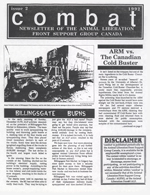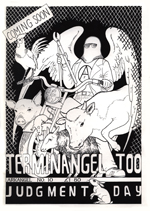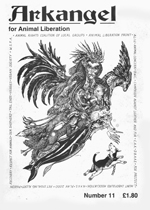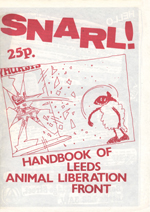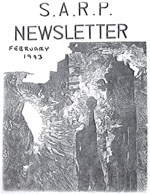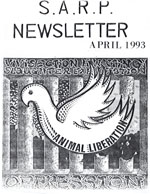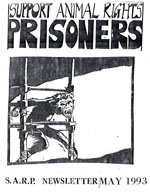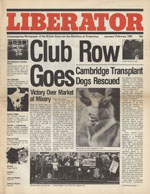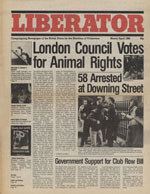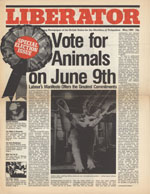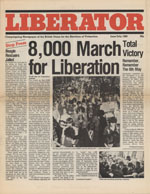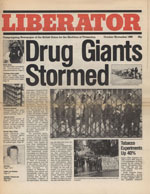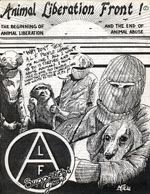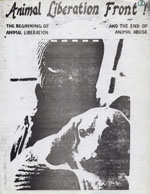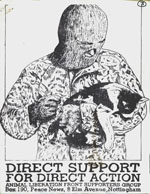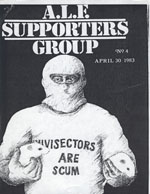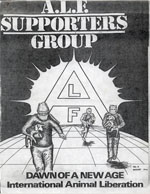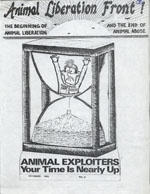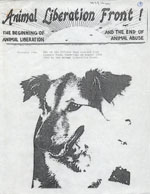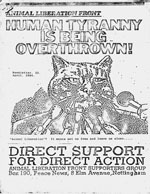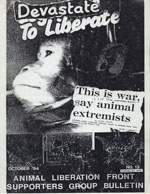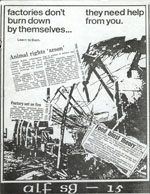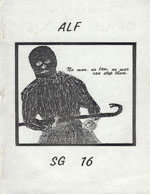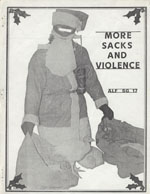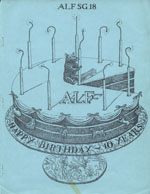The Archives
-
Periodicals
Combat #2
08.28.14 | PermalinkCombat #2 (1992, Edmonton, Alberta, Canada)
A full three years and one month after the posting of Combat #1, we have finally found a copy of the second issue. Rumored to have been almost completely confiscated by RCMP officers the day it came back from the printers, Combat #2 is one of the rarest publications on our site. Our thanks go out to everyone who helped us track it down.
While this issue is far less ambitious than the first issue of Combat, its real problems are the actions that it is covering. Both cover stories were public relations disasters for the animal liberation underground at a time when direct action was already in decline, and one was a disaster for the non-humans it sought to save.
The Cold Buster contamination hoax, like all contamination hoaxes before and after, was mostly successful in convincing the world that animal liberationists were willing to target the public and risk killing random consumers. These hoaxes do generally cause large amounts of financial damage- but none of them has ever stopped a product from being animal tested and it is difficult to believe that the benefits outweigh the costs. When the Animal Rights Militia announced a week after the initial scare that the contamination was a hoax, the media barely paid attention.
The Billingsgate Fish Market action was even more tragic. The action itself involved economic sabotage and arson, both defensible acts against the capture, confinement, and killing of non-humans, except that in this instance fire was set to trucks which were parked directly against the building itself. The flames caused a short circuit to the building’s electrical systems, halting pumps to crab and lobster tanks inside. More than a dozen were killed. While it is true that those animals were already slated for death, it is still unconscionable that their lives were cut short by animal liberators.
This isn’t to say that there is nothing redeeming about this second and final issue of Combat. One of the original messages from the Western Wildlife Unit is presented here unedited, and there are also rare accounts of some of the last major hunt sabotage actions in the United States.
We are happy to have saved this publication from obscurity and to make it available once again here on TALON.
…
-
Arkangel, Periodicals
Arkangel #10-11
07.03.14 | PermalinkArkangel #10-11 (1993-1994. London, England.)
The early 1990s were a tumultuous time for the movement in England. Hunters began hiring professional security services to beat and harass saboteurs, the violence became so extreme that when Tom Worby was murdered by a hunt masters vehicle, the hunters nearby laughed and mocked his death. The hopefulness of the 1980s was fading away, and campaigners were becoming more hardened, which in turn led to a decline in public support as groups like the Justice Department began sending out small mail bombs. Many organizations were mired in infighting over strategy and issues of class and race. And then there was the problem of repression. Scotland Yard’s Animal Rights National Index had gathered detailed profiles on over 21,000 animal liberationists by 1990, and their spying on the movement was only set to intensify.
Through it all a dedicated core of individuals forged ahead and took animals from places of abuse, educated others about the plight of non-humans, and spread the message of compassionate action across oceans and artificial borders. Arkangel tells the story, and we are happy to continue our posting of the complete set here on TALON.
…
-
One-off publications
SNARL! Handbook of the Leeds A.L.F.
11.12.13 | PermalinkSNARL! Handbook Of Leeds ALF (1985. Leeds, England)
One of the great things about punk music is also one of the worst things about it: anyone can do it. On the one hand this encourages kids to destroy the adulation of rockstars and to make music (as well as zines, clothes, art, etc) themselves. That accessibility has brought us the voices of people we never would have otherwise heard, which is wonderful. On the other hand, punk doesn’t exist in a vacuum, it came into being in a culture afflicted with bias and brutality, patriarchy, capitalism, and so on. Those elements are ingrained in many of the creators of punk and are, at times, reflected in the works they produce. Those messages are then carried on to those who consume that media.
It isn’t hard to make the leap from an analysis of punk to an analysis of leaderless resistance. Without a hierarchy or organized recruiting mechanism, the A.L.F. has often spread through the same means as punk rock- DIY media, the passion and anger of youth, and at times, sensationalized mainstream media stories. People have heard the call and picked and up the banner, acting on their own initiative to make change. The downside, of course, is that without a training component that goes beyond a few words in a zine about security culture, these newly active saboteurs aren’t always left with the skill set needed to safely or effectively undertake underground actions. They may end up making their own publications which repeat the mistakes of the ones they first read, and these will be passed on to the consumers of that media.
If I were 16 years old and living in Leeds in 1985, I would have loved SNARL. It speaks from a place of youthful (and righteous) rebelliousness, and although the tone can be a little dogmatic, nearly everything else about the “handbook” is just plain cool. I laughed out loud to see license plates, makes and models of undercover police vehicles listed, and was encouraged to see the inclusion of human liberation struggles. That said, the young folks who made this zine were reproducing some of the worst aspects of other publications from the era as far as security and theatrical militancy goes.
SNARL is an interesting product of it’s time, written and distributed by well meaning, hard-fighting folks who no doubt had the best interest of non-humans in their hearts. That said, I hope readers at the time were cautious in following the advice it contained, because much of it was outright dangerous. Looking at the prisoner listings from this period, that doesn’t seem to be the case.
…
-
Periodicals
S.A.R.P. newsletters year 3
10.25.13 | PermalinkS.A.R.P. Newsletter #12-15 (1993 – Northampton, England)
Only a few short years after reforming Support Animal Rights Prisoners, the contributors to the project (primarily Barry Horne) threw in the towel. Their raison d’être was being fulfilled by the ALF SG newsletters, and Barry felt as if the group wasn’t having the unifying, inspirational impact that he had hoped for. The final issue, mostly written by press officer Robin Webb, starts off light and positive, but ends with an angry missive from Horne accusing most activists of being mere radical t-shirt collectors rather than actual radicals. Across the span of decades and beyond even his own death, this stab at those unwilling to fight for liberation still hits its mark. It is a sad ending to an information packed publication, but not every issue of this last year of SARP is so intense. Tiny fragments of our history fall off these pages like gold dust- collect them together and you have a treasure. Barry might have died on hunger strike, but he did not leave us behind. His words and actions will continue to remind us where we came from, and for whom we fight. Rest in peace, comrade, and thank you for all you have given us…
…
-
BUAV Liberator, Periodicals
BUAV Liberator – 1983
07.16.13 | PermalinkBUAV Liberator (1983. London, England)
The British Union for the Abolition of Vivisection was first established in 1898 by the Irish feminist Frances Power Cobbe. In its long history it has rarely been effective as a fighting force for non-humans, but every so often the organization has a flash of brilliance. In the 1980s, sparked to greater militancy by an explosion of youth activism against vivisection, one of these “flashes” became a conflagration that lasted more than five years.
After shedding their corporate image for something with a little more edge, the BUAV’s publication, “Liberator” became the most important publication during England’s rise of animal lib militancy. While the legislative and educational work of the Union continued, they also incorporated support for direct action. The results were spectacular. Mainstream acceptance of the underground increased, protests grew in size, more people began directly saving non-humans from places of abuse, the grassroots expanded, and unity across the tactical spectrum meant less infighting and more progress for all parties involved.
As always, marriages between moderates and radicals are unstable, and like many others this one ended in a bitter divorce. The BUAV kicked Ronnie Lee’s ALF Press Office out of their building, the SG denounced BUAV as do-nothing liberals, and direct action became harder to support as groups like ARM started sending postal bombs. Still, it was a productive relationship while it lasted, and these newspapers provide an interesting look into just what a national organization for animals can accomplish.
…
-
Most Popular, Periodicals, The SG (original 80s volume)
The ALF Supporters Group Newsletter – The complete original set!
03.04.13 | PermalinkThe ALF Supporters Group Newsletter #1-19 (1982-1986. Nottingham / London, England)
When this archive project was founded two years ago, a list was made of the ten publications that we “had to have.” Number one was a complete set of the first volume of “The SG.” This was a tall order, and we knew it. First off, the Animal Liberation Front Supporters Group must be one of the most raided entities in England, and its members were frequently raided themselves! The result was that many copies of the magazine ended up in police custody both before and after distribution, never to be seen again. Second, it was a relatively old newsletter, and since the first issues were mimeographed on cheap paper, finding intact copies was going to be difficult. We persevered though, and now these rare pieces of movement history are preserved digitally and online for everyone to read and learn from.
Started by Dave Nicholls in 1982, the ALF Supporters Group was an effort to do two things: 1.) To raise funds for people arrested for animal related direct actions. 2.) To create a broader base of support for the Animal Liberation Front inside the movement. Both goals were met quickly. Within two weeks of their founding, the Supporters Group hit the number of members they had set as their long term goal. Through direct donations, memberships, fundraising events, and sales of merchandise, the SG was able to contribute towards the sizable legal costs of activists being arrested across England.
The newsletter itself went through varying degrees of quality in writing, layout, and value to the movement. The early days of the Nicholls run may have had a drab interior, but the hand illustrated covers were sometimes gorgeous, and the rhetoric had not yet strayed into the more-militant-than-thou nonsense which came later. Eventually the writing would border on the cultish, but there is scarcely an issue of the magazine that doesn’t have some redeeming value. When read critically and as a whole body of work, this magazine follows the rise and spread of underground action for animals across the globe, illustrates the value of coalition building, and provides solid examples of extremism to be avoided through coverage of groups like the Animal Rights Militia. It also provides many historical details found nowhere else!
“The SG” has gone through several incarnations since British Law enforcement shut this one down in 1986. (While carrying out the investigation for the notorious Sheffield trial that sent Ronnie Lee to prison for 10 years, the police raided the SG and charged it’s editors with incitement. Everything published by the SG afterwords had to be run past a lawyer first, but this didn’t stop further raids, arrests, and convictions of those involved in the newsletter.) It is still being published today, copies can be ordered from www.alfsg.org.uk.
Finally, an excellent analysis and critique of the SG and the rise of England’s “Cult of Militancy” can be found in the book Against All Odds, available here at the Talon Conspiracy.
…
-
Periodicals
Liberate!
11.06.12 | PermalinkLiberate! #1-7 (1996-1997 Birkenhead, New Zealand)
Liberate! was published by Auckland Animal Action, one of the dozens of militant organizations that suddenly coalesced in the mid-90s. While the activities of the group itself were fairly moderate, the visual direction and rhetoric of the magazine was quite extreme. In it’s era this was appropriate. In these modern days of soy milk in every cafe and vegan cheese in every supermarket, talking about cutting off the fingers of vivisectors is certainly going to frighten away an audience that is already coming around. It wasn’t very long ago, however, that the late 80’s trend of moderation in activism was a clear failure. Dialogue about violence and sabotage was a necessary component of moving forward, and it is important to note that these discussions, thankfully, didn’t result in any missing digits.
Liberate! was not particularly well written, but there are some stand out articles about the burgeoning pro-direct action grassroots, conflicts between environmentalists and animal liberationists, and some entertaining imagery as well. Also of interest, given the current Canadian “Marineland Animal Defense” campaign, are the details of New Zealand’s 90s campaign against their own Marineland.
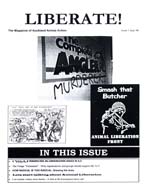
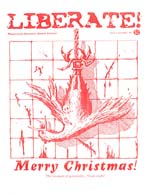
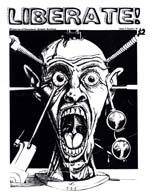
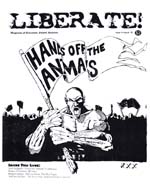
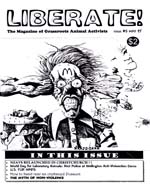
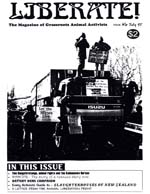
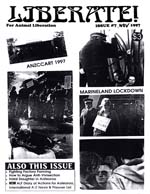
-
One-off publications
A Cat In Hell’s Chance
04.14.12 | PermalinkA Cat In Hell’s Chance (2002, London, England.)
In the annals of animal rights history there are but a handful of legendary campaigns still talked about by activists of all ages. The story of Hill Grove cat farm is one such fabled war, and with good reason. Hill Grove was a watershed moment for the movement and eventually led to the founding of the Stop Huntingdon Animal Cruelty (SHAC) campaign. The battles that raged there included the beating and intentional poisoning of protesters, attacks by company employees, systematic police brutality, a security bill that ran into the millions of British pounds, and eventual victory for the cats being imprisoned in farmer Chris Brown’s compound.
A Cat in Hell’s Chance attempts to document this significant stage in our movement’s development. While the book is in need of a better editor, and is at times disjointed, it does cover all of the major events involved. Including all the way back to the first protests and raids against Hill Grove in the 1980s. Lovers of animal rights history, and young warriors curious about the successful tactics developed by earlier generations, would do well to read this long out of print book.
UPDATE: If you would like a physical copy of this book, it is available through the New Zealand Anti-Vivisection Society and can be found HERE.

-
Periodicals
The Animal Liberation Front Supporters Group Newsletter #17
07.17.11 | PermalinkThe Animal Liberation Front Supporters Group Newsletter #17 (1985, London, England.)
(Editors note: The complete set of SG newsletters is now available HERE.)
It is not usually our habit to put up a single issue of a serialized publication as we prefer to post an entire year, or run of magazines, in a single post. However, we must make an exception for the ALF SG Newsletter #17, which contains a fantastic investigation of the Band of Mercy and comes complete with an image of their first press statement from November of 1973. The significance of that image, the very first communique from an underground group fighting on behalf of other species, can not be understated.
When one considers how entrenched animal exploitation is in our culture, the idea that a tiny band of revolutionaries could push back against that social tide by burning down an animal laboratory under construction is a watershed moment. The arson attacks and raids carried out by the Band of Mercy were pivotal in the creation of the animal rights movement.
This issue has much more in store for readers. The second communique from the Animal Rights Militia is presented in it’s entirety, and although it provides a myopic examination of the role of liberatory violence it is none the less a fascinating read for lovers of animal rights history. The story of the famous Ecclesfield Beagle raid is presented by one of it’s participants, Roger Yates has a long letter explaining his feelings on the uselessness of national groups, and funny pseudonyms abound! If you thought Earth First!ers had funny names, wait till you get a load of Captain Kirk, Martial Rose, and Black Vixen!
If you look carefully you may notice that this issue is missing some pages. We do not know if this is because they were removed by their original owner, or if this is one of the issues of the SG rumored to have been “edited” by the British government as it left post offices on it’s way to subscribers.

…
-
Books
Animal Warfare
06.12.11 | PermalinkAnimal Warfare (1989, David Henshaw, London, England)
Based upon a television show of the same name, Animal Warfare was one of the first books written about the rise of animal liberation militancy. Its author, David Henshaw, is decidedly anti-animal rights, and at times his coverage is so unfair and deceitful that it’s tempting to write this publication off as mere tabloid journalism. That would be a mistake. While clearly written from the perspective of a person intent on smearing activists, this paperback also provides us with a look at our history less slanted by movement propagandizing and cheerleading. At times that picture is not pretty.
Authored during the rise of what some English activists called “the cult of militancy,” Animal Warfare takes the fodder provided by the most extreme actions of the early 80s and spins an ugly tale of car-bombs, poisoning hoaxes, graveyard desecration, and alliances with racist organizations such as the National Front. While there are plenty of grotesque distortions of facts, there are also valuable lessons to be learned about how the best tactical decisions consider our movement’s ability to survive backlash while building mass.
At a time when many modern activists seem intent on repeating the mistakes of the past, (or at least blogging as if they intend on repeating those mistakes), Animal Warfare contributes to our ability to learn about media falsification, the dangers of militaristic posturing, and the events which led to the weakening of England’s mass militant movement for animal liberation.
…
